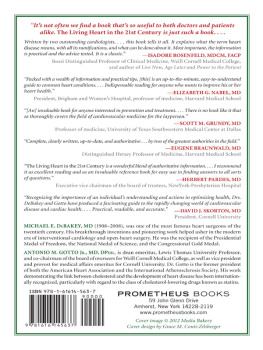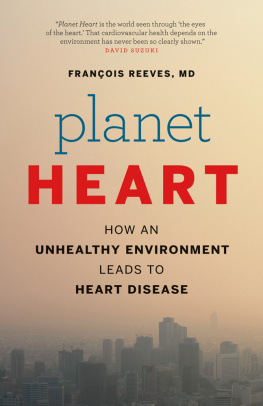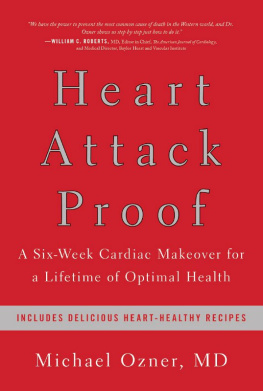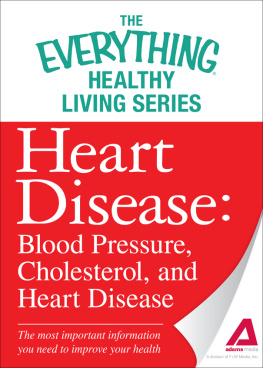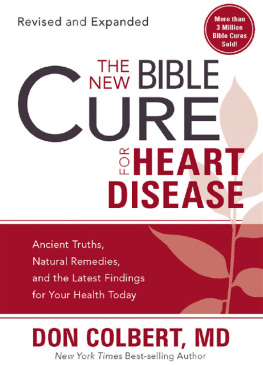
N umerous colleagues have contributed their time and expertise to the prior editions of this book. Their efforts, particularly the illustrations by Herbert R. Smith Jr., continue to enrich the current version. We would like to thank John Farmer, MD, and Guillermo Torre-Amione, MD, in Houston, Texas, who provided invaluable feedback during the planning stages for this project. We greatly appreciate the assistance of George Bell, MD, who reviewed the chapters dealing with the diagnosis and management of different forms of heart disease. We are also grateful to Frank Weimann and Elyse Tanzillo at The Literary Group International and to Steven L. Mitchell, Linda Greenspan Regan, and everyone at Prometheus Books for bringing this project to fruition. Special thanks goes to Jennifer Moon, PhD, for her research and writing assistance with this book.


O ne of the most frequent causes of heart disease is atherosclerosis. Atherosclerosis is a lifelong process that leads to the thickening and hardening of artery walls. It is the underlying cause of nearly three-fourths of all cardiovascular deaths. Atherosclerotic plaques, also called lesions, can develop in the coronary arteries that surround the heart muscle and provide it with blood (see ). These plaques reduce the flow of blood and oxygen to the heart, which can cause the chest pain or discomfort of angina. In more severe cases of coronary heart disease, the plaques entirely block the flow of blood to the heart, or they rupture, producing large blood clots that can then cut off the heart's blood supply. In both instances, the result is a heart attack, or what doctors call a myocardial infarction.
Heart attacks are a very common form of heart disease. According to the American Heart Association, one heart attack occurs approximately every twenty-five seconds in the United States. Every minute, a person dies from one. In one year, approximately 785,000 Americans will have a first attack, while about 470,000 will have a repeat attack. Many of these events can be prevented by implementing healthy lifestyle changes and by controlling risk factors for atherosclerotic vascular disease.
A heart attack is just one of the events that can occur due to atherosclerosis. Atherosclerosis can also develop in any of the major arteries and in the aorta, the large vessel that carries blood away from the heart (see carotid arteries in the neck or the cerebral arteries in the brain can block blood flow to the brain, causing a stroke or transient ischemic attack (TIA). In addition, plaques can reduce the flow of blood and oxygen to surrounding tissues, which may eventually die. Atherosclerosis that develops in the femoral arteries of the leg or in the brachial arteries of the arms, called peripheral artery disease (PAD), can cause pain, decreased function, and in severe cases, gangrene leading to amputation. Atherosclerosis of the renal arteries in the kidney can cause high blood pressure and eventual kidney failure. Finally, the consequences of atherosclerosis can lead to arrhythmias (disorders of heart rate or rhythm), heart failure, and other conditions affecting the heart.

Understanding how coronary heart disease (CHD) and atherosclerosis develop is the first step in prevention. Many people in the twenty-first-century United States have high-fat, sedentary lifestyles that greatly increase the risk of developing atherosclerosis. However, atherosclerosis is not just a modern disease. Evidence of atherosclerosis has been found in Egyptian mummies dating from the third millennium BCE and in Peruvian remains from the first millennium BCE. The difference is that now, in the twenty-first century, we understand how and why atherosclerosis develops, as well as key strategies for prevention. This chapter highlights the major concepts about atherosclerosis that have emerged after more than a century of scientific research and due to recent advances in molecular biology. The story begins with cholesterol.



WHY CHOLESTEROL?
In 1904, a German pathologist named Felix Marchand first proposed the term atherosclerosis to describe a process that nineteenth-century physicians were aware of but did not yet understand. Marchand chose this name because of the appearance of the arteries he examined: athero is the Greek root for gruel or porridge, while sclerosis is the root for hardening. His choice emphasized the resemblance between the fatty atherosclerotic plaques found within hardened arteries and porridge. At the time, physicians did not know what material these soft, pulpy deposits consisted of, or what effect they might have on the body.
In 1913, scientists got their first real clue when a Russian scientist named Nikolai Anichkov fed rabbits cholesterol purified from egg yolks and was able to produce the same gruel-like deposits found in human arteries. Anichkov also determined that the amount of cholesterol fed to the rabbits was related to the size and number of plaques that developed. Scientists did not fully recognize the significance of his findings until decades later. Now, however, it is clear that cholesterol is a major component of atherosclerotic lesions and that high levels of cholesterol in the blood, or plasma, can cause atherosclerosis and its many complications.
In the middle of the twentieth century, researchers studying large populations discovered a relationship between saturated fat consumption, total cholesterol levels, and heart disease. In the 1950s, the Seven Countries Study found that high consumption of saturated fat in countries such as the United States and Finland led to increased blood cholesterol levels and to much higher rates of heart disease, as compared to countries with low saturated fat consumption, such as Japan, Greece, and Italy.
WHAT IS CHOLESTEROL?
Cholesterol belongs to a group of naturally occurring molecules called lipids. The term lipid is often used to refer to fats, but lipids are actually a class of molecules, including fats, oils, waxes, and sterols, that can be dissolved in other fats, oils, and lipids but not in water (they are lipophilic). A major function of lipids is energy storage, which is how we commonly think of fats and oils. Other functions of lipids include maintaining the structure of cell membranes and regulating a wide variety of cellular activities, especially those that involve molecular signaling.
Cholesterol is a simple lipid. (Because of its chemical structure, it is also classified as an alcohol and as a form of steroid called a sterol.) Fatty acids, which are derived from animal and vegetable fats and oils, are another type of simple lipid. Omega fatty acids, for example, are most commonly found in fish.
Next page
